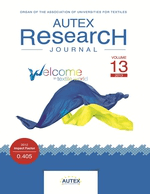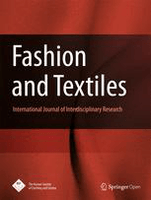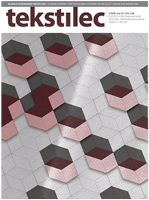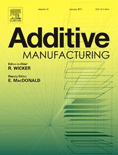
Autex Research Journal
Scope & Guideline
Empowering scholars with cutting-edge insights in textile technology.
Introduction
Aims and Scopes
- Textile Materials Science:
Research in this area includes the development, characterization, and performance analysis of various textile materials, including natural and synthetic fibers, composites, and innovative blends. - Garment and Apparel Design:
This scope covers the design, modeling, and evaluation of clothing, focusing on aspects such as fit, comfort, aesthetics, and functional properties. - Sustainable Textiles and Eco-Friendly Practices:
The journal emphasizes sustainable practices in textile production, including the use of biodegradable materials, recycling, and environmentally friendly manufacturing processes. - Smart Textiles and Wearable Technology:
Research on integrating technology into textiles, such as smart fabrics that monitor health or environmental conditions, is a key focus area. - Textile Manufacturing Processes:
This includes studies on various manufacturing techniques, process optimization, and innovations in machinery and equipment used in textile production. - Textile Applications in Health and Safety:
Research related to the application of textiles in medical, protective, and safety gear, highlighting their performance in critical applications.
Trending and Emerging
- Digital Fabrication and Virtual Modeling:
An increasing number of studies are exploring digital techniques for textile design and manufacturing, including 3D modeling and virtual simulations, which enhance creativity and precision in garment design. - Smart Textiles and Health Monitoring:
Research in smart textiles that incorporate sensors and wearable technology for health monitoring is gaining prominence, showcasing the intersection of textiles and health sciences. - Sustainability in Textile Production:
The focus on sustainable practices, including circular economy principles and the use of renewable resources in textile production, is becoming increasingly critical in the journal's publications. - Advanced Textile Composites:
There is a growing interest in developing and analyzing advanced textile composites that combine various materials to enhance performance in diverse applications. - Consumer-Centric Design Approaches:
Research that incorporates consumer preferences and behaviors, such as fit satisfaction and emotional responses to clothing design, is emerging as a significant theme in the journal.
Declining or Waning
- Traditional Textile Dyeing Techniques:
There has been a noticeable reduction in studies focused on conventional dyeing techniques, possibly due to the increasing emphasis on sustainable and eco-friendly dyeing methods. - Basic Mechanical Properties of Textiles:
Research that solely examines the basic mechanical properties of textiles without integrating advanced composites or smart technology has been less frequent, reflecting a trend towards more complex analyses. - Historical Textile Studies:
Papers that delve into historical or archaeological aspects of textiles have seen dwindling attention, as the focus shifts towards contemporary applications and innovations.
Similar Journals

FIBRES & TEXTILES IN EASTERN EUROPE
Bridging Research and Application in Eastern European TextilesFIBRES & TEXTILES IN EASTERN EUROPE, published by the Lukasiewicz Research Network - Lodz Institute of Technology, is a prominent academic journal dedicated to advancing knowledge in the fields of materials science, engineering, and environmental research within the textile industries of Eastern Europe. Since its inception in 1993, this journal has become a vital resource for researchers, professionals, and students alike, focusing on the latest innovations and trends in fiber and textile technology. With an impressive classification of Q3 in several categories, including Business and International Management, Environmental Science, and Industrial Manufacturing Engineering, it aims to bridge the gap between research and practical application. Although it is an open-access journal, readers can easily access valuable insights and findings that are crucial for both academic and industrial stakeholders. As global sustainability and material efficiency become increasingly pressing issues, FIBRES & TEXTILES IN EASTERN EUROPE plays an essential role in disseminating research that addresses these challenges while promoting collaboration across diverse disciplines.

Research Journal of Textile and Apparel
Fostering collaboration in textile and apparel scholarship.Research Journal of Textile and Apparel, published by Emerald Group Publishing Ltd, serves as a pivotal platform for advancing knowledge in the fields of textile and apparel research. With an ISSN of 1560-6074, this journal has been disseminating quality research since its inception in 1997, and it continues to contribute valuable insights through to 2024. The journal holds a Q3 ranking across multiple categories, including Business and International Management, Industrial and Manufacturing Engineering, Management of Technology and Innovation, and Materials Science, reflecting its commitment to high standards of scholarship. Although not an open-access journal, it provides a vital resource for researchers, professionals, and students eager to explore innovative textile technologies and sustainable practices within the fashion industry. As the textile sector navigates significant challenges and opportunities, this journal is uniquely positioned to foster collaboration and enhance understanding among diverse stakeholders.

International Journal of Precision Engineering and Manufacturing-Green Technology
Pioneering the future of sustainable engineering.International Journal of Precision Engineering and Manufacturing-Green Technology, published by the Korean Society of Precision Engineering, serves as an influential platform dedicated to advancing the fields of engineering and manufacturing with a strong emphasis on sustainability and green technology. Operating in the realm of precision engineering, this journal has firmly established itself within the academic community, boasting impressive Scopus rankings across multiple categories, including Q1 rankings in Industrial and Manufacturing Engineering and Mechanical Engineering, and Q2 in Renewable Energy and Sustainability. With its comprehensive coverage of innovative practices and cutting-edge research from 2014 to 2024, the journal addresses critical challenges faced by industries today while fostering interdisciplinary collaboration among researchers, professionals, and students. Although it does not offer open access, its insights are invaluable for those committed to pioneering sustainable solutions in engineering and manufacturing.

Tekstil ve Konfeksiyon
Connecting Researchers and Practitioners in Textile InnovationTekstil ve Konfeksiyon, a distinguished journal published by the E.U. Printing and Publishing House, serves as a vital resource in the fields of Industrial and Manufacturing Engineering as well as Materials Science. With an ISSN of 1300-3356, this Turkish journal has witnessed significant development since its inception in 2008, continuing to contribute valuable insights and advancements through 2024. Although categorized in the third quartile (Q3) for Industrial and Manufacturing Engineering and the fourth quartile (Q4) for Materials Science, the journal ranks respectably within its fields—249th out of 384 and 357th out of 463, respectively, according to Scopus. Researchers, professionals, and students can gain access to a variety of cutting-edge studies and applications that reflect the latest trends and innovations in textile and apparel technology. The journal emphasizes the importance of practical applications and interdisciplinary research, fostering a platform for knowledge exchange and development aimed at pushing the boundaries of textile and clothing sciences.

Fashion and Textiles
Transforming Trends into Academic InsightFashion and Textiles is a distinguished open-access journal published by Springer, focusing on the interdisciplinary realms surrounding fashion, textile innovation, and their socio-cultural implications. Since its inception in 2014, this journal has aimed to foster a deeper understanding of the rapidly evolving landscape of fashion and textiles through rigorous research and scholarly discourse. With an impressive Q1 ranking in Cultural Studies and prominent positions in several other categories, including Marketing and Social Psychology, the journal holds a significant place in its field. The journal, based in Singapore and accessible globally, provides authors and readers with a platform for high-quality research exchanges that influence both academia and industry practices. Open access since its launch, it has proven to be an essential resource for researchers, practitioners, and students who seek to contribute to and engage with the latest trends and developments in fashion and textiles.

Journal of Fiber Science and Technology
Fostering Collaboration in Fiber TechnologyJournal of Fiber Science and Technology is a pivotal scholarly publication dedicated to advancing the field of fiber science, encompassing the study of fibers and textiles across various applications. Published by SOC FIBER SCIENCE TECHNOLOGY in Japan, this journal has been a significant forum for innovative research since its inception, with coverage from as early as 1946. Despite its current categorization in the Q4 quartile across multiple disciplines including Chemical Engineering, Industrial and Manufacturing Engineering, and Materials Science, the journal provides a valuable platform for the dissemination of knowledge, fostering collaboration among researchers, professionals, and students alike. The journal promotes an interactive learning environment, welcoming contributions that underscore the latest advancements in fiber materials, processing technologies, and their broad industrial implications. By bridging theory and practical application, the Journal of Fiber Science and Technology is essential in shaping the future of fiber technology.

Tekstilec
Innovating textile solutions for a dynamic industrial landscape.Tekstilec, an esteemed journal published by University of Ljubljana, Slovenia, has been a prominent platform in the fields of textiles, engineering, and industrial management since its establishment in 1989. With an Open Access model since 2000, the journal ensures that scholarly research is accessible to a global audience, fostering the dissemination of knowledge across various disciplines. While its impact factor remains unlisted, Tekstilec holds respectable rankings within its categorized quartiles, featuring a 2023 Q4 ranking in Business and International Management and Q3 rankings in multiple engineering and material science categories. This positions the journal as a vital resource for researchers, professionals, and students seeking insights into textiles and their multidisciplinary applications. With a commitment to advancing knowledge in its scope, Tekstilec invites contributions that explore innovative research and practical developments, encouraging collaboration within the global academic community.

Journal of Cotton Science
Exploring the Depths of Cotton ResearchJournal of Cotton Science is a vital publication dedicated to advancing the understanding and innovative practices within the cotton industry. Published by the NATIONAL COTTON COUNCIL OF AMERICA, this journal has been a key resource for researchers, agronomists, and industry professionals since its inception in 1997, with contributions spanning various aspects of cotton science, including breeding, genetics, pest management, and environmental impact. With an ISSN of 1523-6919 and an E-ISSN of 1524-3303, it currently holds a Q3 ranking in the Materials Science (miscellaneous) category as per the 2023 quartiles. While the journal operates without open access, it remains accessible to professionals looking to contribute to its expanding reach. The Journal of Cotton Science plays a pivotal role in disseminating cutting-edge research and fostering collaboration among scientists, positioning itself as an essential resource in the ongoing exploration of cotton's material science applications. Stay up to date with the latest findings and developments that shape the future of this crucial agricultural product.

Additive Manufacturing
Fostering Excellence in the World of Additive TechnologiesAdditive Manufacturing is a leading international journal published by ELSEVIER, dedicated to the advancements and transformative applications of additive manufacturing technologies across various disciplines. Since its inception in 2014, it has emerged as a pivotal resource in the fields of Biomedical Engineering, Industrial and Manufacturing Engineering, and Materials Science, with an impressive impact factor and ranking in the Q1 quartile across multiple categories as of 2023. The journal serves as a platform for cutting-edge research, state-of-the-art techniques, and novel applications in additive manufacturing, making it essential reading for researchers, industry professionals, and students alike. By fostering a comprehensive understanding of the challenges and innovations within the field, Additive Manufacturing plays a crucial role in shaping the future of production technologies. With a strong readership and rigorous peer-review process, this journal ensures that its contributions remain at the forefront of manufacturing research and development.

INDIAN JOURNAL OF FIBRE & TEXTILE RESEARCH
Championing groundbreaking insights in fibre and textile research.INDIAN JOURNAL OF FIBRE & TEXTILE RESEARCH (ISSN: 0971-0426, E-ISSN: 0975-1025) is a leading platform dedicated to advancing the field of textile research and innovation. Published by the NATIONAL INSTITUTE OF SCIENCE COMMUNICATION-NISCAIR in India, this open access journal has been fostering knowledge sharing since its establishment in 2006. With a broad scope encompassing Chemical Engineering, Environmental Science, and Materials Science, the journal's convergence from 1990 to 2024 highlights its commitment to ongoing academic dialogue. Currently categorized as Q3 in several disciplines, including Chemical Engineering and Environmental Science, it provides critical insights into contemporary challenges and developments. The journal's Scopus rankings further illustrate its influence within the research community, making it an essential resource for researchers, professionals, and students interested in textile technology and its intersections with sustainable practices. By fostering a collaborative environment for sharing pioneering research, the INDIAN JOURNAL OF FIBRE & TEXTILE RESEARCH stands as a vital conduit for scholarly communication in the textile sector.